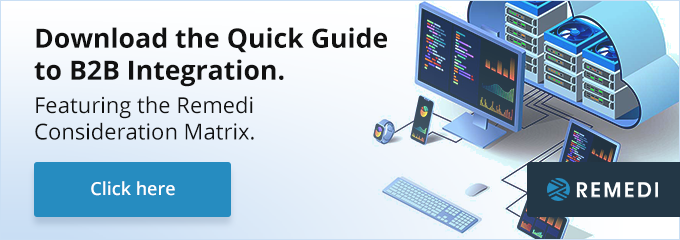
One of the biggest obstacles facing any modernization initiative is the cost. To convince the C-suite that B2B integration modernization is the right choice for you, you have to be ready for an intelligent conversation about the total cost of ownership (TCO).
In this article, we’ll explore how to prepare yourself to talk about TCO, and how to make the case for investing in modern EDI.
What Elements Go into TCO?
When you talk about the cost of a B2B integration solution, the price that the vendor quotes you isn’t the final price. There are several other factors that go into the solution’s total cost.
You also must consider how much it will cost to:
- Maintain
- Deploy
- Upgrade software and hardware
- Operate the same asset throughout its anticipated service life
- Support
- Train users
There are also hidden fees, which your vendor doesn’t talk about during discussions about cost. Hidden fees and expenses for modern EDI solutions include:
- Finance fees
- Servers and storage for software
- Backup and recovery expenses
- Implementation fees (which include setting up, configuring, and testing the software)
- External system interfaces (so your solution can “talk” to other systems)
- Data migration (so that B2B integration solutions can access legacy data, which includes reformatting the data so it can be consumed by the B2B integration solution)
- Customization (so the modern EDI solution fits into your workflows, rather than your having to adapt to processes)
- Patches for vulnerabilities
- Data center costs, such as electricity, cooling, rack space, security, maintenance, and management
- Downtime (when the software isn’t available)

Don’t forget about staffing, either. You’ll need people to manage your B2B integration system, whether those team members are in-house or external. These roles include:
- Project manager
- Map developer
- Applications integrator
- Web forms developer
- Internal B2B IT support personnel
- External trading partner-facing IT support personnel
- Help desk monitor(s)
Not all of these roles need to be full-time, though. Moreover, some of them can be filled by the same person.
Addressing the Elephant in the Boardroom
Discussing money is often uncomfortable, especially when you’re trying to convince decision makers to make a substantial financial investment in a solution they don’t entirely understand (nor grasp the benefits of). However, as difficult as this discussion may be, you can’t ignore the cost issue—the C-suite needs to know how much a solution is going to cost overall, including the hidden costs.
How do you ensure that you successfully make the case for B2B integration, in spite of bringing up the elephant in, this case, the boardroom? You can’t look at TCO in a vacuum: it has to be weighed against the alternative of the status quo. Research how much it will cost you to keep going along the route you’re on now.
“You can’t look at TCO in a vacuum: what’s the cost of sticking with the status quo?”
Present decision makers with information that shows how the investment in B2B integration will be worth more than it would be to keep doing things the same way. With B2B integration, you can:
- Meet customers’ needs by fulfilling their EDI requirements
- Reach new customers who use B2B integration
- Create a competitive differentiator
- Effectively handle rapid growth
Addressing the elephant in the boardroom can be difficult, but it’s not impossible to convince decision makers about the need for B2B integration when they understand TCO. Are You Ready to Integrate?




